Mobile App Security: Critical Evaluation Report - Coursework
VerifiedAdded on 2023/06/07
|12
|3011
|60
Report
AI Summary
This report presents a critical evaluation of research papers on mobile app security. The student analyzes two journal publications, examining the clarity of the research questions, the adequacy of literature review, and the appropriateness of the methodologies used. The evaluation delves into the significance of the research, assessing whether the papers effectively explained their purpose, gathered sufficient evidence, and drew valid conclusions. The report discusses the impact of cloud computing on mobile applications, explores various security measures, and analyzes the differences between iOS and Android platforms. It also addresses ethical considerations and biases within the research methods, including data collection techniques and potential limitations such as guideline bias, selection bias, and transfer bias. The study highlights the increasing threats to mobile devices and emphasizes the importance of security in the evolving landscape of mobile computing.
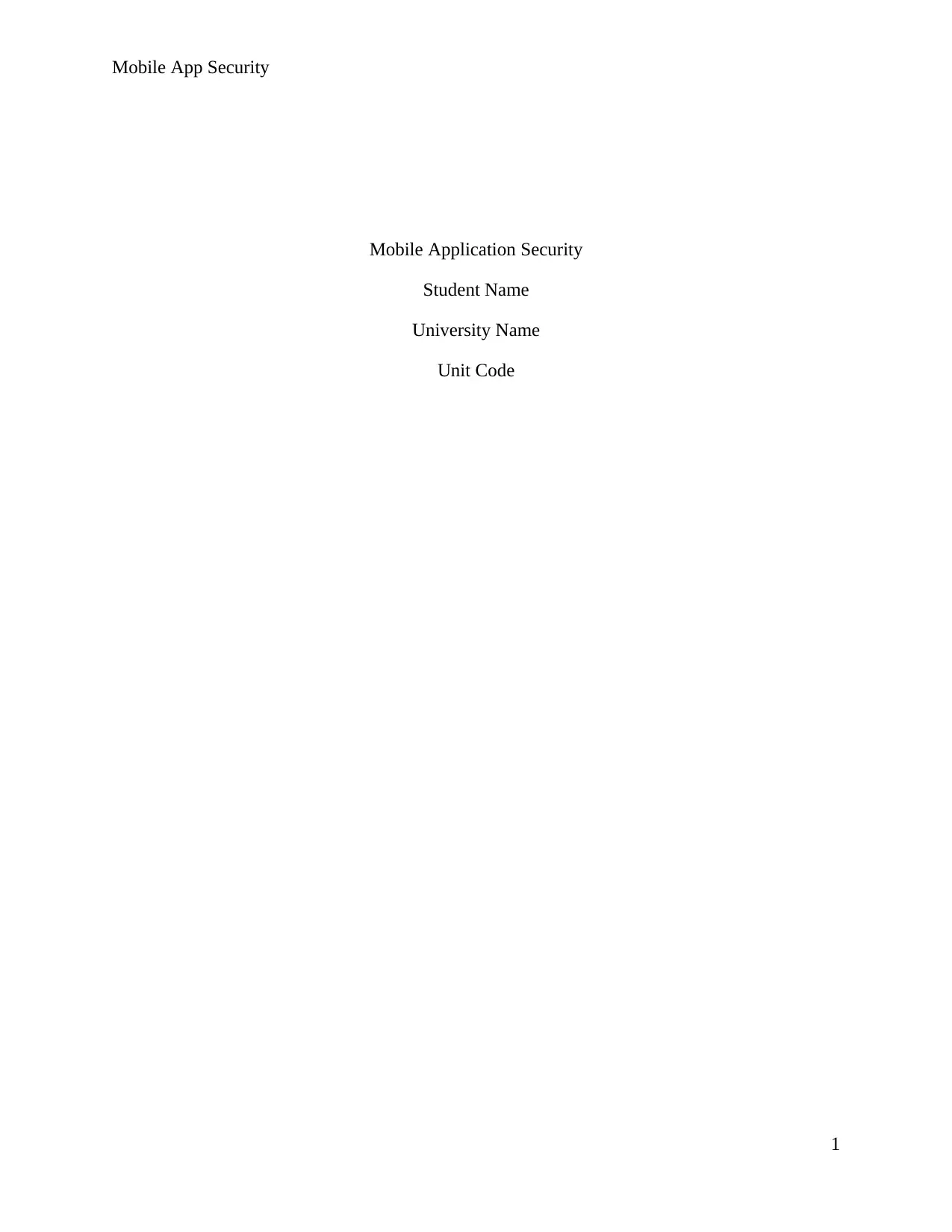
Mobile App Security
Mobile Application Security
Student Name
University Name
Unit Code
1
Mobile Application Security
Student Name
University Name
Unit Code
1
Paraphrase This Document
Need a fresh take? Get an instant paraphrase of this document with our AI Paraphraser
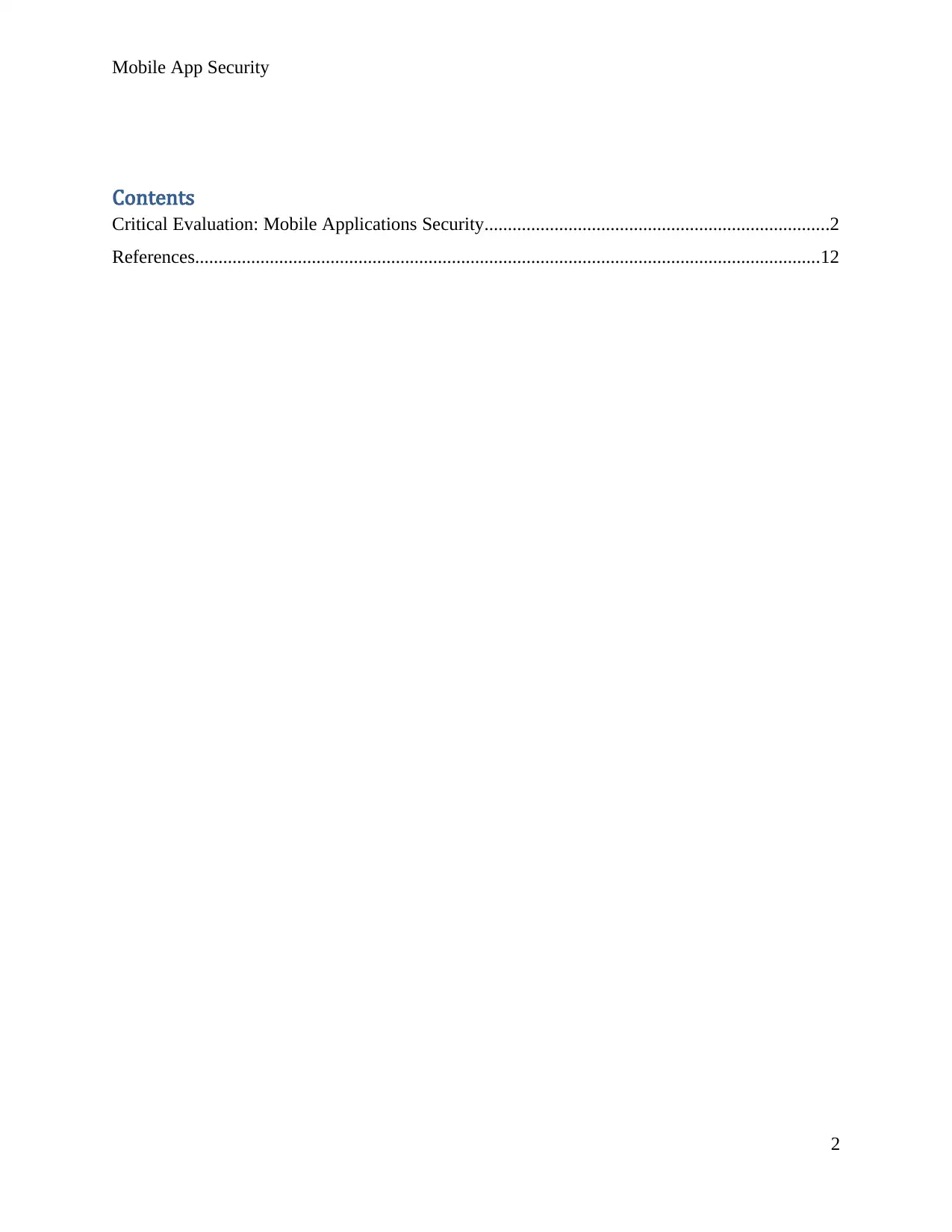
Mobile App Security
Contents
Critical Evaluation: Mobile Applications Security..........................................................................2
References......................................................................................................................................12
2
Contents
Critical Evaluation: Mobile Applications Security..........................................................................2
References......................................................................................................................................12
2
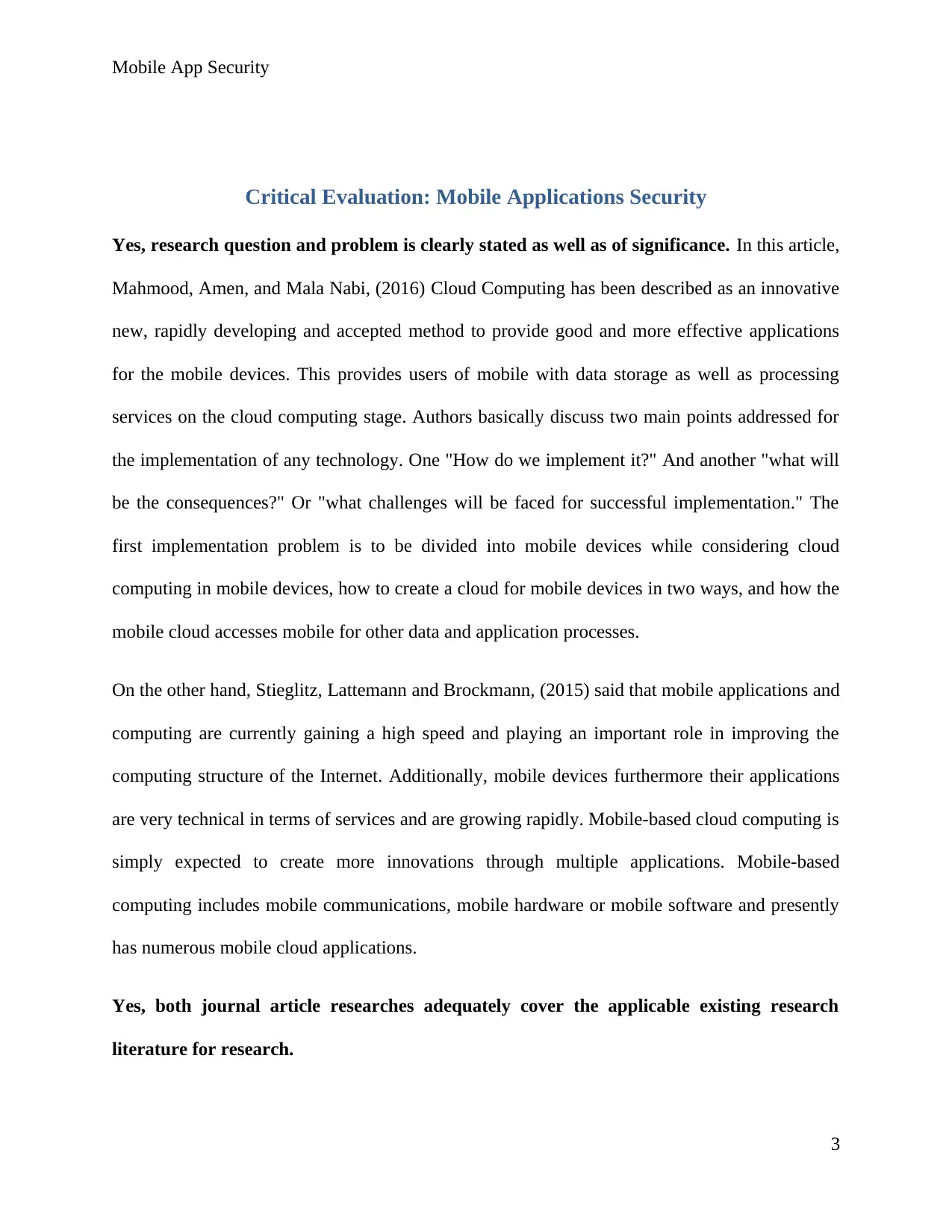
Mobile App Security
Critical Evaluation: Mobile Applications Security
Yes, research question and problem is clearly stated as well as of significance. In this article,
Mahmood, Amen, and Mala Nabi, (2016) Cloud Computing has been described as an innovative
new, rapidly developing and accepted method to provide good and more effective applications
for the mobile devices. This provides users of mobile with data storage as well as processing
services on the cloud computing stage. Authors basically discuss two main points addressed for
the implementation of any technology. One "How do we implement it?" And another "what will
be the consequences?" Or "what challenges will be faced for successful implementation." The
first implementation problem is to be divided into mobile devices while considering cloud
computing in mobile devices, how to create a cloud for mobile devices in two ways, and how the
mobile cloud accesses mobile for other data and application processes.
On the other hand, Stieglitz, Lattemann and Brockmann, (2015) said that mobile applications and
computing are currently gaining a high speed and playing an important role in improving the
computing structure of the Internet. Additionally, mobile devices furthermore their applications
are very technical in terms of services and are growing rapidly. Mobile-based cloud computing is
simply expected to create more innovations through multiple applications. Mobile-based
computing includes mobile communications, mobile hardware or mobile software and presently
has numerous mobile cloud applications.
Yes, both journal article researches adequately cover the applicable existing research
literature for research.
3
Critical Evaluation: Mobile Applications Security
Yes, research question and problem is clearly stated as well as of significance. In this article,
Mahmood, Amen, and Mala Nabi, (2016) Cloud Computing has been described as an innovative
new, rapidly developing and accepted method to provide good and more effective applications
for the mobile devices. This provides users of mobile with data storage as well as processing
services on the cloud computing stage. Authors basically discuss two main points addressed for
the implementation of any technology. One "How do we implement it?" And another "what will
be the consequences?" Or "what challenges will be faced for successful implementation." The
first implementation problem is to be divided into mobile devices while considering cloud
computing in mobile devices, how to create a cloud for mobile devices in two ways, and how the
mobile cloud accesses mobile for other data and application processes.
On the other hand, Stieglitz, Lattemann and Brockmann, (2015) said that mobile applications and
computing are currently gaining a high speed and playing an important role in improving the
computing structure of the Internet. Additionally, mobile devices furthermore their applications
are very technical in terms of services and are growing rapidly. Mobile-based cloud computing is
simply expected to create more innovations through multiple applications. Mobile-based
computing includes mobile communications, mobile hardware or mobile software and presently
has numerous mobile cloud applications.
Yes, both journal article researches adequately cover the applicable existing research
literature for research.
3
⊘ This is a preview!⊘
Do you want full access?
Subscribe today to unlock all pages.

Trusted by 1+ million students worldwide
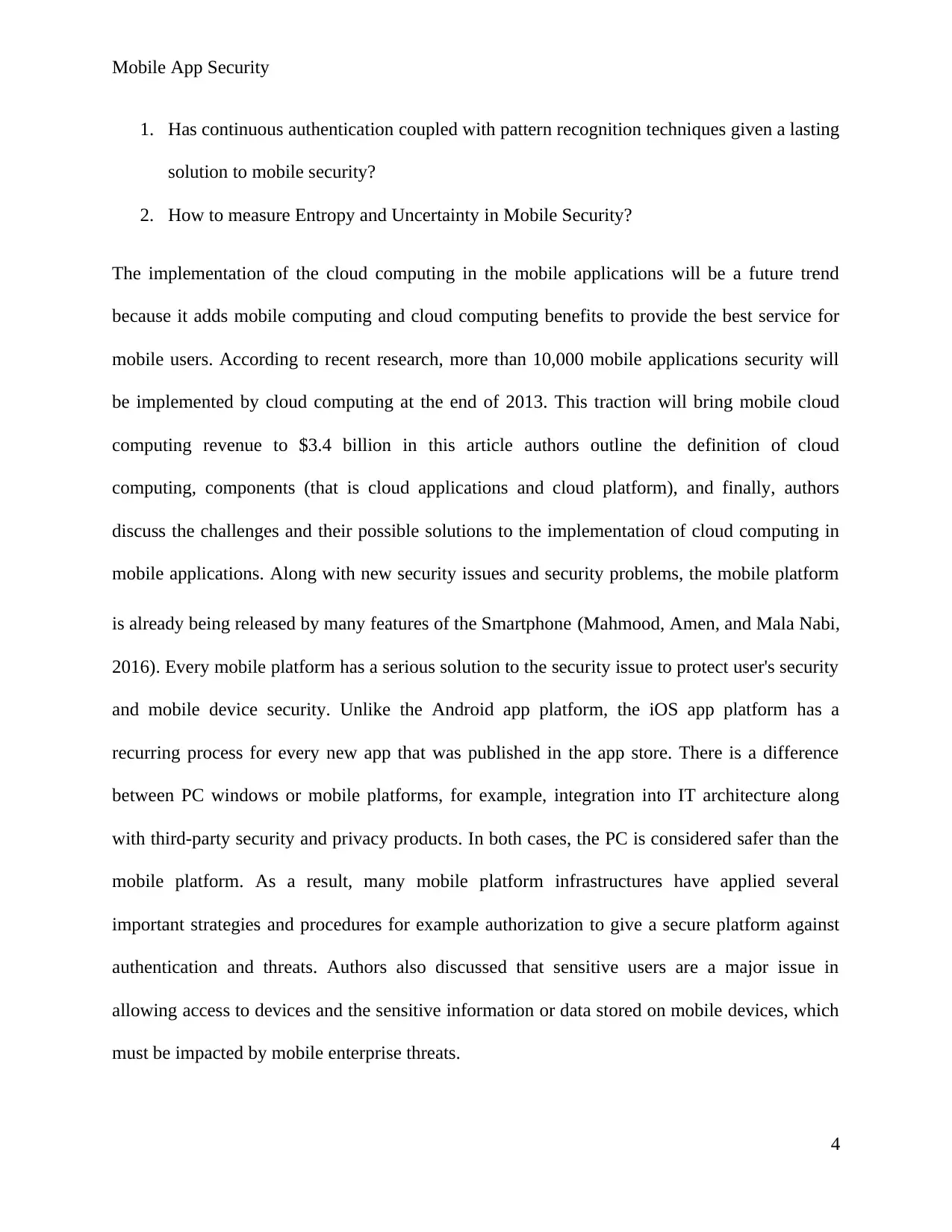
Mobile App Security
1. Has continuous authentication coupled with pattern recognition techniques given a lasting
solution to mobile security?
2. How to measure Entropy and Uncertainty in Mobile Security?
The implementation of the cloud computing in the mobile applications will be a future trend
because it adds mobile computing and cloud computing benefits to provide the best service for
mobile users. According to recent research, more than 10,000 mobile applications security will
be implemented by cloud computing at the end of 2013. This traction will bring mobile cloud
computing revenue to $3.4 billion in this article authors outline the definition of cloud
computing, components (that is cloud applications and cloud platform), and finally, authors
discuss the challenges and their possible solutions to the implementation of cloud computing in
mobile applications. Along with new security issues and security problems, the mobile platform
is already being released by many features of the Smartphone (Mahmood, Amen, and Mala Nabi,
2016). Every mobile platform has a serious solution to the security issue to protect user's security
and mobile device security. Unlike the Android app platform, the iOS app platform has a
recurring process for every new app that was published in the app store. There is a difference
between PC windows or mobile platforms, for example, integration into IT architecture along
with third-party security and privacy products. In both cases, the PC is considered safer than the
mobile platform. As a result, many mobile platform infrastructures have applied several
important strategies and procedures for example authorization to give a secure platform against
authentication and threats. Authors also discussed that sensitive users are a major issue in
allowing access to devices and the sensitive information or data stored on mobile devices, which
must be impacted by mobile enterprise threats.
4
1. Has continuous authentication coupled with pattern recognition techniques given a lasting
solution to mobile security?
2. How to measure Entropy and Uncertainty in Mobile Security?
The implementation of the cloud computing in the mobile applications will be a future trend
because it adds mobile computing and cloud computing benefits to provide the best service for
mobile users. According to recent research, more than 10,000 mobile applications security will
be implemented by cloud computing at the end of 2013. This traction will bring mobile cloud
computing revenue to $3.4 billion in this article authors outline the definition of cloud
computing, components (that is cloud applications and cloud platform), and finally, authors
discuss the challenges and their possible solutions to the implementation of cloud computing in
mobile applications. Along with new security issues and security problems, the mobile platform
is already being released by many features of the Smartphone (Mahmood, Amen, and Mala Nabi,
2016). Every mobile platform has a serious solution to the security issue to protect user's security
and mobile device security. Unlike the Android app platform, the iOS app platform has a
recurring process for every new app that was published in the app store. There is a difference
between PC windows or mobile platforms, for example, integration into IT architecture along
with third-party security and privacy products. In both cases, the PC is considered safer than the
mobile platform. As a result, many mobile platform infrastructures have applied several
important strategies and procedures for example authorization to give a secure platform against
authentication and threats. Authors also discussed that sensitive users are a major issue in
allowing access to devices and the sensitive information or data stored on mobile devices, which
must be impacted by mobile enterprise threats.
4
Paraphrase This Document
Need a fresh take? Get an instant paraphrase of this document with our AI Paraphraser
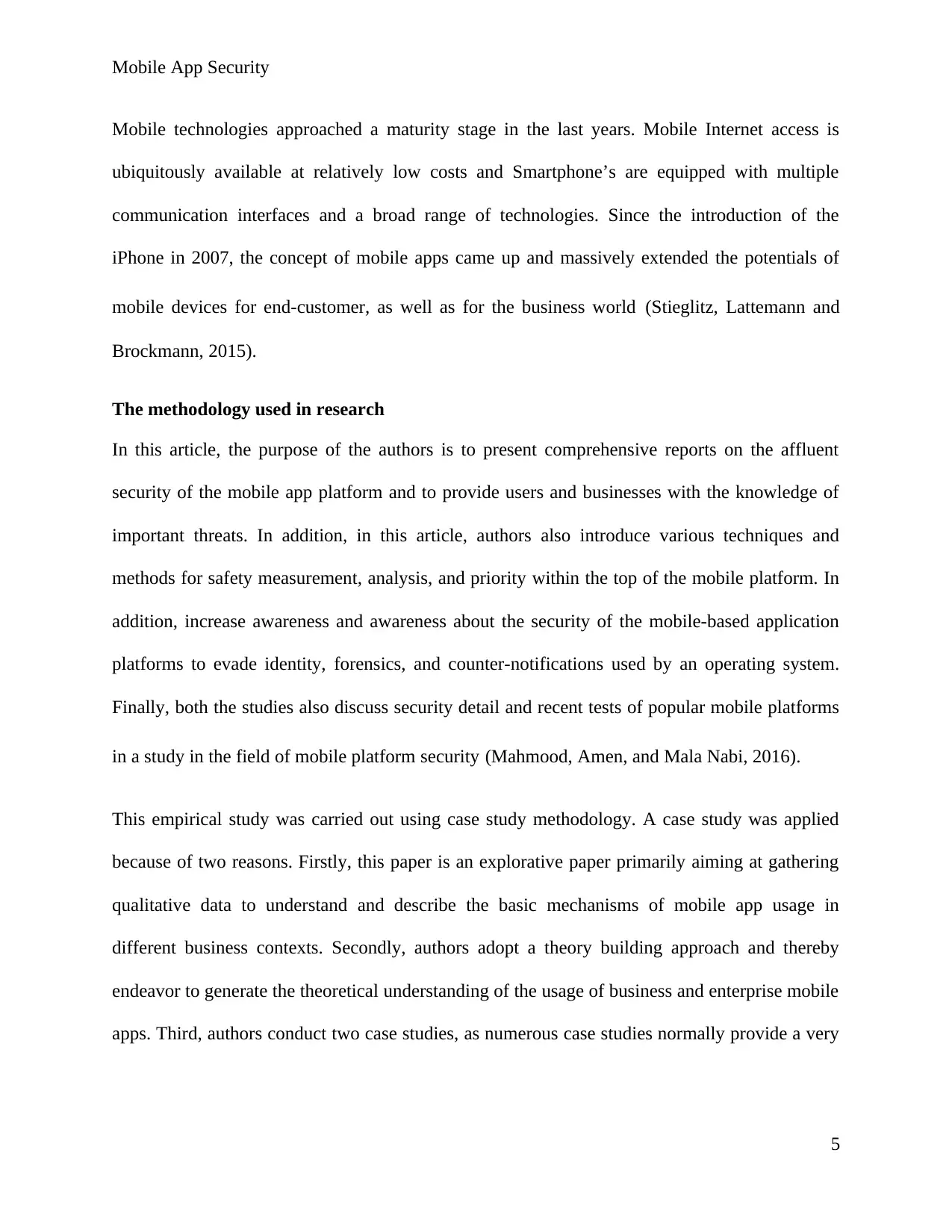
Mobile App Security
Mobile technologies approached a maturity stage in the last years. Mobile Internet access is
ubiquitously available at relatively low costs and Smartphone’s are equipped with multiple
communication interfaces and a broad range of technologies. Since the introduction of the
iPhone in 2007, the concept of mobile apps came up and massively extended the potentials of
mobile devices for end-customer, as well as for the business world (Stieglitz, Lattemann and
Brockmann, 2015).
The methodology used in research
In this article, the purpose of the authors is to present comprehensive reports on the affluent
security of the mobile app platform and to provide users and businesses with the knowledge of
important threats. In addition, in this article, authors also introduce various techniques and
methods for safety measurement, analysis, and priority within the top of the mobile platform. In
addition, increase awareness and awareness about the security of the mobile-based application
platforms to evade identity, forensics, and counter-notifications used by an operating system.
Finally, both the studies also discuss security detail and recent tests of popular mobile platforms
in a study in the field of mobile platform security (Mahmood, Amen, and Mala Nabi, 2016).
This empirical study was carried out using case study methodology. A case study was applied
because of two reasons. Firstly, this paper is an explorative paper primarily aiming at gathering
qualitative data to understand and describe the basic mechanisms of mobile app usage in
different business contexts. Secondly, authors adopt a theory building approach and thereby
endeavor to generate the theoretical understanding of the usage of business and enterprise mobile
apps. Third, authors conduct two case studies, as numerous case studies normally provide a very
5
Mobile technologies approached a maturity stage in the last years. Mobile Internet access is
ubiquitously available at relatively low costs and Smartphone’s are equipped with multiple
communication interfaces and a broad range of technologies. Since the introduction of the
iPhone in 2007, the concept of mobile apps came up and massively extended the potentials of
mobile devices for end-customer, as well as for the business world (Stieglitz, Lattemann and
Brockmann, 2015).
The methodology used in research
In this article, the purpose of the authors is to present comprehensive reports on the affluent
security of the mobile app platform and to provide users and businesses with the knowledge of
important threats. In addition, in this article, authors also introduce various techniques and
methods for safety measurement, analysis, and priority within the top of the mobile platform. In
addition, increase awareness and awareness about the security of the mobile-based application
platforms to evade identity, forensics, and counter-notifications used by an operating system.
Finally, both the studies also discuss security detail and recent tests of popular mobile platforms
in a study in the field of mobile platform security (Mahmood, Amen, and Mala Nabi, 2016).
This empirical study was carried out using case study methodology. A case study was applied
because of two reasons. Firstly, this paper is an explorative paper primarily aiming at gathering
qualitative data to understand and describe the basic mechanisms of mobile app usage in
different business contexts. Secondly, authors adopt a theory building approach and thereby
endeavor to generate the theoretical understanding of the usage of business and enterprise mobile
apps. Third, authors conduct two case studies, as numerous case studies normally provide a very
5
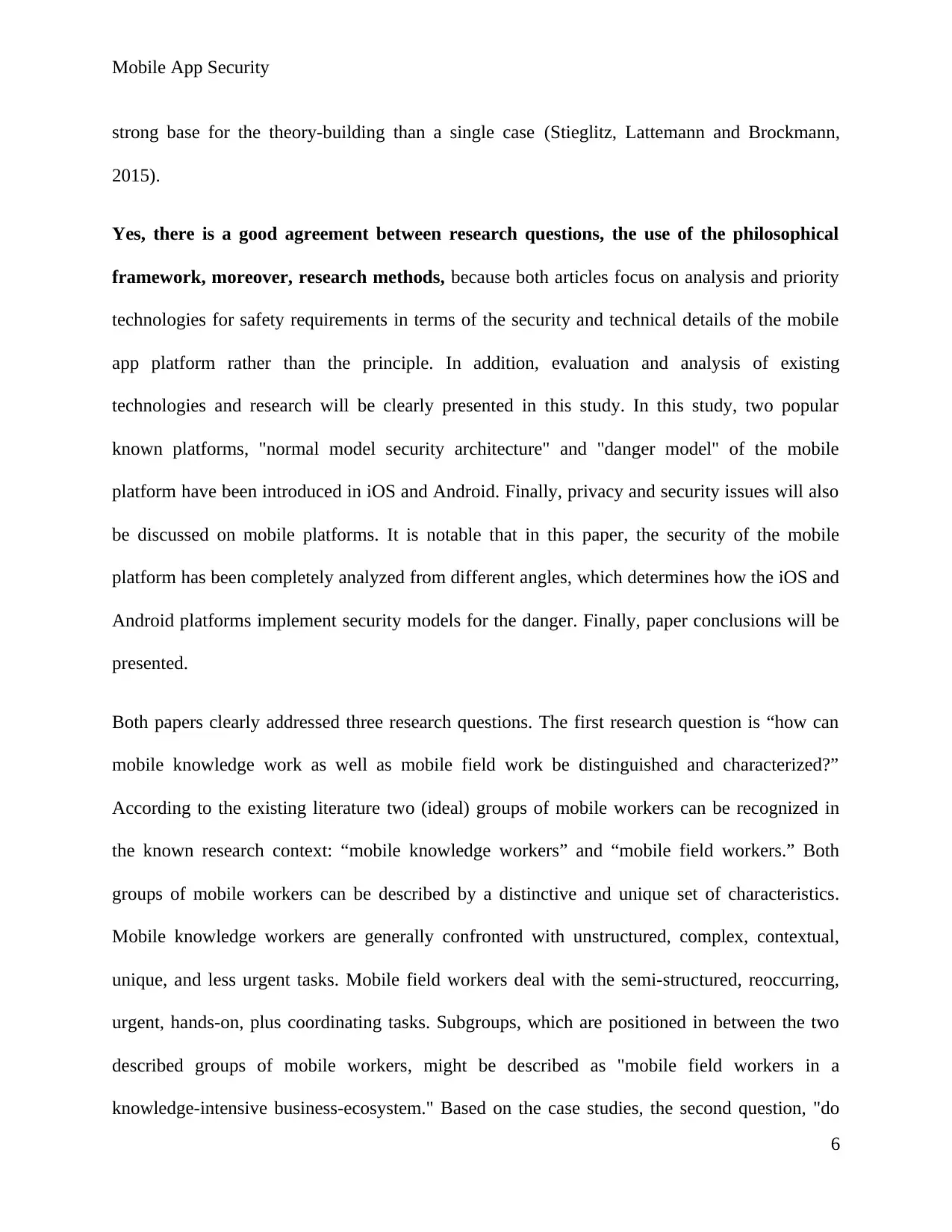
Mobile App Security
strong base for the theory-building than a single case (Stieglitz, Lattemann and Brockmann,
2015).
Yes, there is a good agreement between research questions, the use of the philosophical
framework, moreover, research methods, because both articles focus on analysis and priority
technologies for safety requirements in terms of the security and technical details of the mobile
app platform rather than the principle. In addition, evaluation and analysis of existing
technologies and research will be clearly presented in this study. In this study, two popular
known platforms, "normal model security architecture" and "danger model" of the mobile
platform have been introduced in iOS and Android. Finally, privacy and security issues will also
be discussed on mobile platforms. It is notable that in this paper, the security of the mobile
platform has been completely analyzed from different angles, which determines how the iOS and
Android platforms implement security models for the danger. Finally, paper conclusions will be
presented.
Both papers clearly addressed three research questions. The first research question is “how can
mobile knowledge work as well as mobile field work be distinguished and characterized?”
According to the existing literature two (ideal) groups of mobile workers can be recognized in
the known research context: “mobile knowledge workers” and “mobile field workers.” Both
groups of mobile workers can be described by a distinctive and unique set of characteristics.
Mobile knowledge workers are generally confronted with unstructured, complex, contextual,
unique, and less urgent tasks. Mobile field workers deal with the semi-structured, reoccurring,
urgent, hands-on, plus coordinating tasks. Subgroups, which are positioned in between the two
described groups of mobile workers, might be described as "mobile field workers in a
knowledge-intensive business-ecosystem." Based on the case studies, the second question, "do
6
strong base for the theory-building than a single case (Stieglitz, Lattemann and Brockmann,
2015).
Yes, there is a good agreement between research questions, the use of the philosophical
framework, moreover, research methods, because both articles focus on analysis and priority
technologies for safety requirements in terms of the security and technical details of the mobile
app platform rather than the principle. In addition, evaluation and analysis of existing
technologies and research will be clearly presented in this study. In this study, two popular
known platforms, "normal model security architecture" and "danger model" of the mobile
platform have been introduced in iOS and Android. Finally, privacy and security issues will also
be discussed on mobile platforms. It is notable that in this paper, the security of the mobile
platform has been completely analyzed from different angles, which determines how the iOS and
Android platforms implement security models for the danger. Finally, paper conclusions will be
presented.
Both papers clearly addressed three research questions. The first research question is “how can
mobile knowledge work as well as mobile field work be distinguished and characterized?”
According to the existing literature two (ideal) groups of mobile workers can be recognized in
the known research context: “mobile knowledge workers” and “mobile field workers.” Both
groups of mobile workers can be described by a distinctive and unique set of characteristics.
Mobile knowledge workers are generally confronted with unstructured, complex, contextual,
unique, and less urgent tasks. Mobile field workers deal with the semi-structured, reoccurring,
urgent, hands-on, plus coordinating tasks. Subgroups, which are positioned in between the two
described groups of mobile workers, might be described as "mobile field workers in a
knowledge-intensive business-ecosystem." Based on the case studies, the second question, "do
6
⊘ This is a preview!⊘
Do you want full access?
Subscribe today to unlock all pages.

Trusted by 1+ million students worldwide
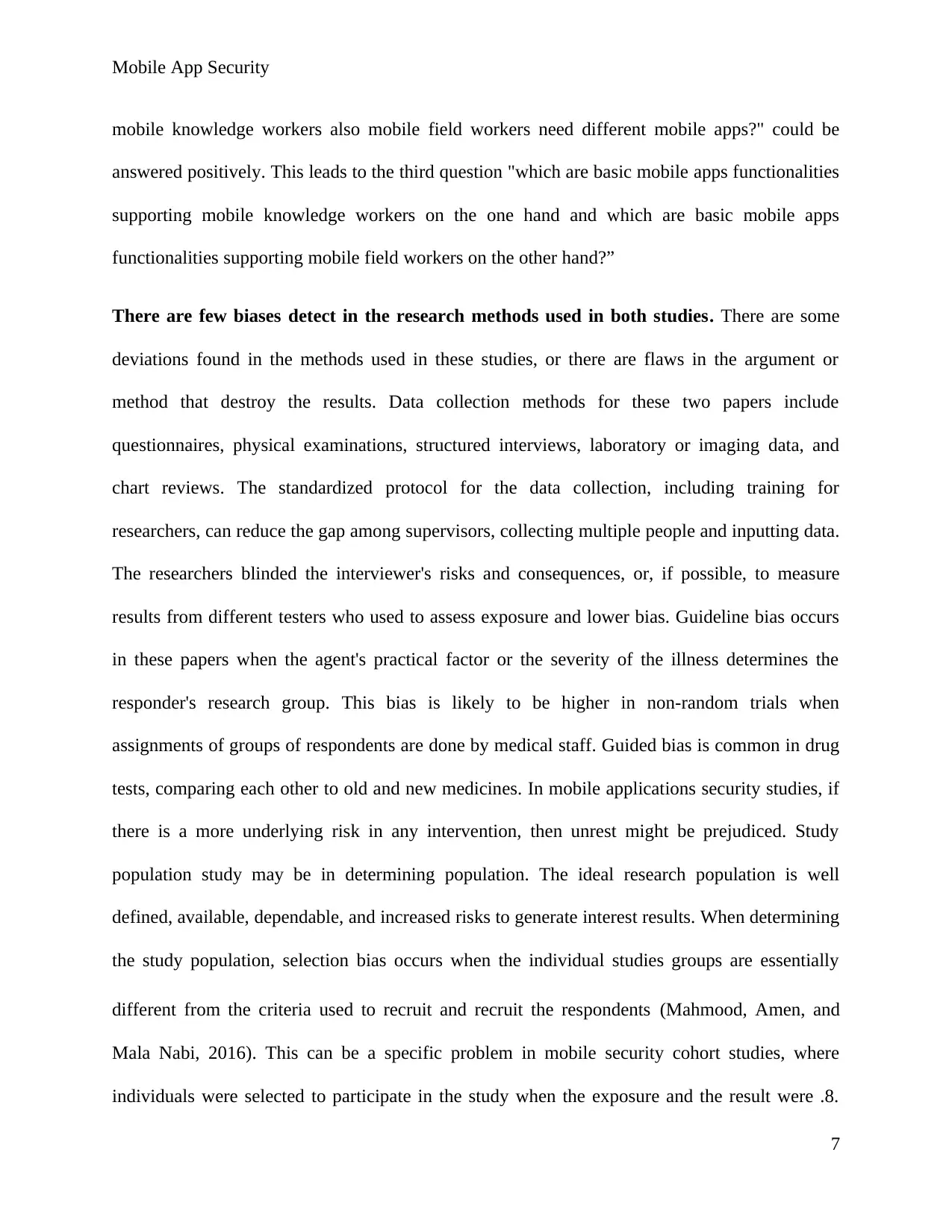
Mobile App Security
mobile knowledge workers also mobile field workers need different mobile apps?" could be
answered positively. This leads to the third question "which are basic mobile apps functionalities
supporting mobile knowledge workers on the one hand and which are basic mobile apps
functionalities supporting mobile field workers on the other hand?”
There are few biases detect in the research methods used in both studies. There are some
deviations found in the methods used in these studies, or there are flaws in the argument or
method that destroy the results. Data collection methods for these two papers include
questionnaires, physical examinations, structured interviews, laboratory or imaging data, and
chart reviews. The standardized protocol for the data collection, including training for
researchers, can reduce the gap among supervisors, collecting multiple people and inputting data.
The researchers blinded the interviewer's risks and consequences, or, if possible, to measure
results from different testers who used to assess exposure and lower bias. Guideline bias occurs
in these papers when the agent's practical factor or the severity of the illness determines the
responder's research group. This bias is likely to be higher in non-random trials when
assignments of groups of respondents are done by medical staff. Guided bias is common in drug
tests, comparing each other to old and new medicines. In mobile applications security studies, if
there is a more underlying risk in any intervention, then unrest might be prejudiced. Study
population study may be in determining population. The ideal research population is well
defined, available, dependable, and increased risks to generate interest results. When determining
the study population, selection bias occurs when the individual studies groups are essentially
different from the criteria used to recruit and recruit the respondents (Mahmood, Amen, and
Mala Nabi, 2016). This can be a specific problem in mobile security cohort studies, where
individuals were selected to participate in the study when the exposure and the result were .8.
7
mobile knowledge workers also mobile field workers need different mobile apps?" could be
answered positively. This leads to the third question "which are basic mobile apps functionalities
supporting mobile knowledge workers on the one hand and which are basic mobile apps
functionalities supporting mobile field workers on the other hand?”
There are few biases detect in the research methods used in both studies. There are some
deviations found in the methods used in these studies, or there are flaws in the argument or
method that destroy the results. Data collection methods for these two papers include
questionnaires, physical examinations, structured interviews, laboratory or imaging data, and
chart reviews. The standardized protocol for the data collection, including training for
researchers, can reduce the gap among supervisors, collecting multiple people and inputting data.
The researchers blinded the interviewer's risks and consequences, or, if possible, to measure
results from different testers who used to assess exposure and lower bias. Guideline bias occurs
in these papers when the agent's practical factor or the severity of the illness determines the
responder's research group. This bias is likely to be higher in non-random trials when
assignments of groups of respondents are done by medical staff. Guided bias is common in drug
tests, comparing each other to old and new medicines. In mobile applications security studies, if
there is a more underlying risk in any intervention, then unrest might be prejudiced. Study
population study may be in determining population. The ideal research population is well
defined, available, dependable, and increased risks to generate interest results. When determining
the study population, selection bias occurs when the individual studies groups are essentially
different from the criteria used to recruit and recruit the respondents (Mahmood, Amen, and
Mala Nabi, 2016). This can be a specific problem in mobile security cohort studies, where
individuals were selected to participate in the study when the exposure and the result were .8.
7
Paraphrase This Document
Need a fresh take? Get an instant paraphrase of this document with our AI Paraphraser
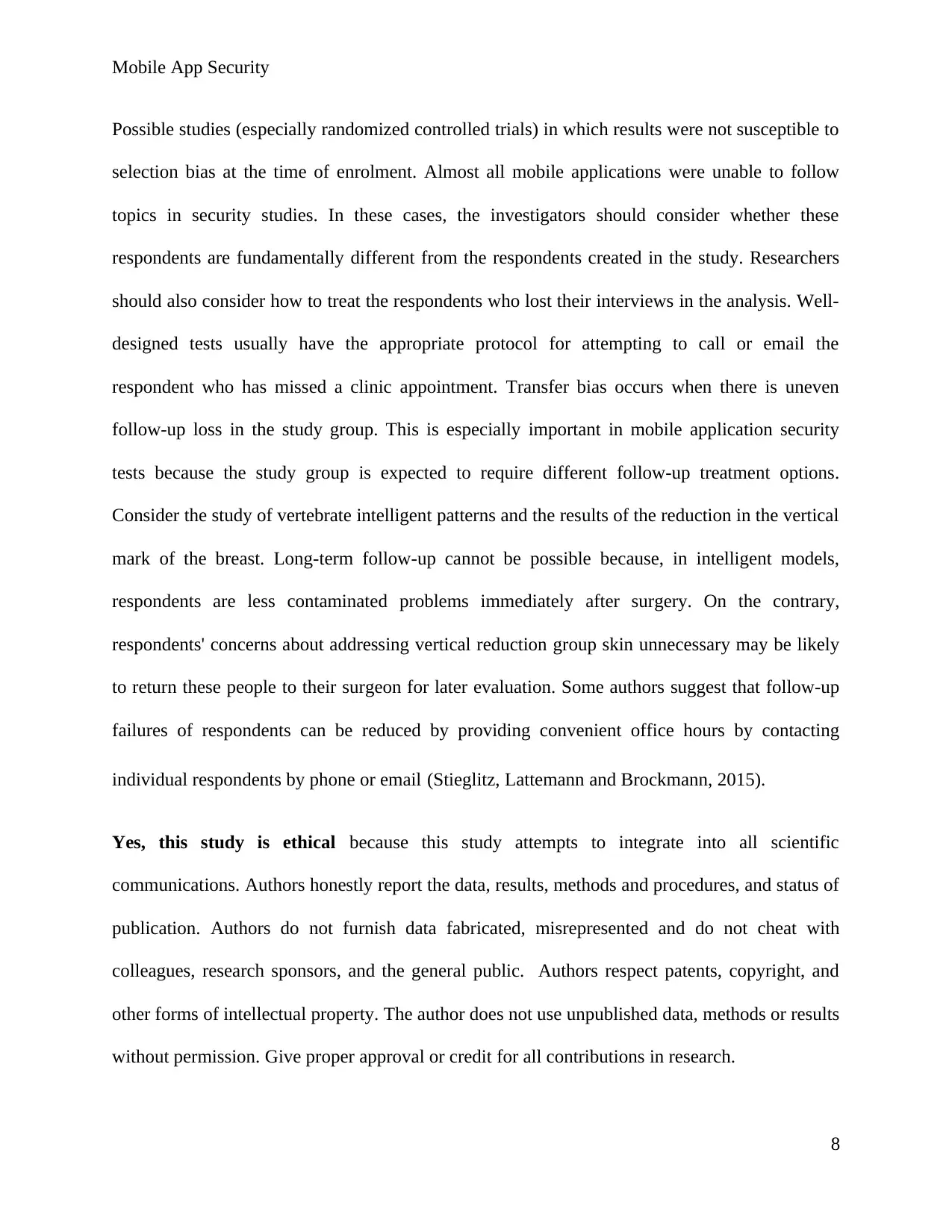
Mobile App Security
Possible studies (especially randomized controlled trials) in which results were not susceptible to
selection bias at the time of enrolment. Almost all mobile applications were unable to follow
topics in security studies. In these cases, the investigators should consider whether these
respondents are fundamentally different from the respondents created in the study. Researchers
should also consider how to treat the respondents who lost their interviews in the analysis. Well-
designed tests usually have the appropriate protocol for attempting to call or email the
respondent who has missed a clinic appointment. Transfer bias occurs when there is uneven
follow-up loss in the study group. This is especially important in mobile application security
tests because the study group is expected to require different follow-up treatment options.
Consider the study of vertebrate intelligent patterns and the results of the reduction in the vertical
mark of the breast. Long-term follow-up cannot be possible because, in intelligent models,
respondents are less contaminated problems immediately after surgery. On the contrary,
respondents' concerns about addressing vertical reduction group skin unnecessary may be likely
to return these people to their surgeon for later evaluation. Some authors suggest that follow-up
failures of respondents can be reduced by providing convenient office hours by contacting
individual respondents by phone or email (Stieglitz, Lattemann and Brockmann, 2015).
Yes, this study is ethical because this study attempts to integrate into all scientific
communications. Authors honestly report the data, results, methods and procedures, and status of
publication. Authors do not furnish data fabricated, misrepresented and do not cheat with
colleagues, research sponsors, and the general public. Authors respect patents, copyright, and
other forms of intellectual property. The author does not use unpublished data, methods or results
without permission. Give proper approval or credit for all contributions in research.
8
Possible studies (especially randomized controlled trials) in which results were not susceptible to
selection bias at the time of enrolment. Almost all mobile applications were unable to follow
topics in security studies. In these cases, the investigators should consider whether these
respondents are fundamentally different from the respondents created in the study. Researchers
should also consider how to treat the respondents who lost their interviews in the analysis. Well-
designed tests usually have the appropriate protocol for attempting to call or email the
respondent who has missed a clinic appointment. Transfer bias occurs when there is uneven
follow-up loss in the study group. This is especially important in mobile application security
tests because the study group is expected to require different follow-up treatment options.
Consider the study of vertebrate intelligent patterns and the results of the reduction in the vertical
mark of the breast. Long-term follow-up cannot be possible because, in intelligent models,
respondents are less contaminated problems immediately after surgery. On the contrary,
respondents' concerns about addressing vertical reduction group skin unnecessary may be likely
to return these people to their surgeon for later evaluation. Some authors suggest that follow-up
failures of respondents can be reduced by providing convenient office hours by contacting
individual respondents by phone or email (Stieglitz, Lattemann and Brockmann, 2015).
Yes, this study is ethical because this study attempts to integrate into all scientific
communications. Authors honestly report the data, results, methods and procedures, and status of
publication. Authors do not furnish data fabricated, misrepresented and do not cheat with
colleagues, research sponsors, and the general public. Authors respect patents, copyright, and
other forms of intellectual property. The author does not use unpublished data, methods or results
without permission. Give proper approval or credit for all contributions in research.
8
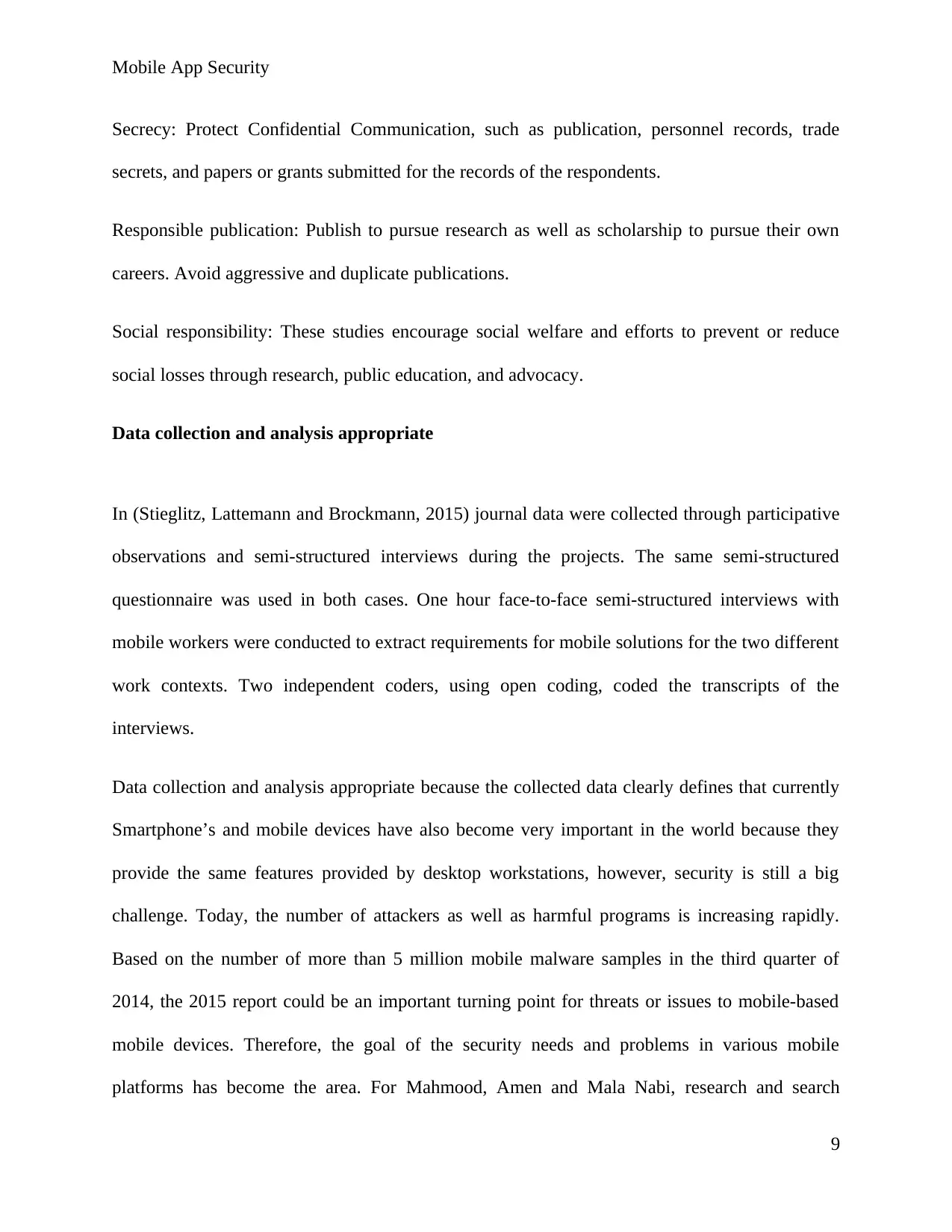
Mobile App Security
Secrecy: Protect Confidential Communication, such as publication, personnel records, trade
secrets, and papers or grants submitted for the records of the respondents.
Responsible publication: Publish to pursue research as well as scholarship to pursue their own
careers. Avoid aggressive and duplicate publications.
Social responsibility: These studies encourage social welfare and efforts to prevent or reduce
social losses through research, public education, and advocacy.
Data collection and analysis appropriate
In (Stieglitz, Lattemann and Brockmann, 2015) journal data were collected through participative
observations and semi-structured interviews during the projects. The same semi-structured
questionnaire was used in both cases. One hour face-to-face semi-structured interviews with
mobile workers were conducted to extract requirements for mobile solutions for the two different
work contexts. Two independent coders, using open coding, coded the transcripts of the
interviews.
Data collection and analysis appropriate because the collected data clearly defines that currently
Smartphone’s and mobile devices have also become very important in the world because they
provide the same features provided by desktop workstations, however, security is still a big
challenge. Today, the number of attackers as well as harmful programs is increasing rapidly.
Based on the number of more than 5 million mobile malware samples in the third quarter of
2014, the 2015 report could be an important turning point for threats or issues to mobile-based
mobile devices. Therefore, the goal of the security needs and problems in various mobile
platforms has become the area. For Mahmood, Amen and Mala Nabi, research and search
9
Secrecy: Protect Confidential Communication, such as publication, personnel records, trade
secrets, and papers or grants submitted for the records of the respondents.
Responsible publication: Publish to pursue research as well as scholarship to pursue their own
careers. Avoid aggressive and duplicate publications.
Social responsibility: These studies encourage social welfare and efforts to prevent or reduce
social losses through research, public education, and advocacy.
Data collection and analysis appropriate
In (Stieglitz, Lattemann and Brockmann, 2015) journal data were collected through participative
observations and semi-structured interviews during the projects. The same semi-structured
questionnaire was used in both cases. One hour face-to-face semi-structured interviews with
mobile workers were conducted to extract requirements for mobile solutions for the two different
work contexts. Two independent coders, using open coding, coded the transcripts of the
interviews.
Data collection and analysis appropriate because the collected data clearly defines that currently
Smartphone’s and mobile devices have also become very important in the world because they
provide the same features provided by desktop workstations, however, security is still a big
challenge. Today, the number of attackers as well as harmful programs is increasing rapidly.
Based on the number of more than 5 million mobile malware samples in the third quarter of
2014, the 2015 report could be an important turning point for threats or issues to mobile-based
mobile devices. Therefore, the goal of the security needs and problems in various mobile
platforms has become the area. For Mahmood, Amen and Mala Nabi, research and search
9
⊘ This is a preview!⊘
Do you want full access?
Subscribe today to unlock all pages.

Trusted by 1+ million students worldwide
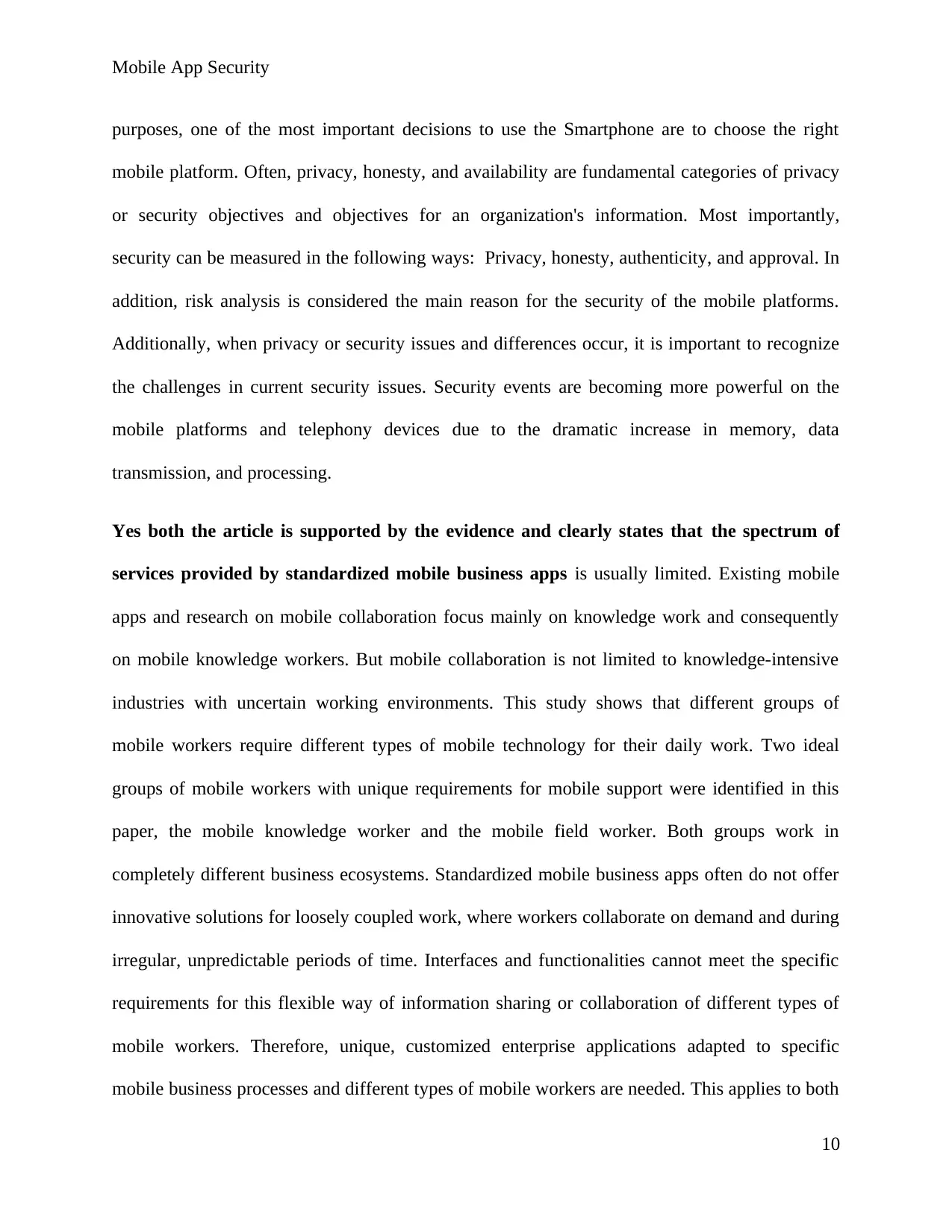
Mobile App Security
purposes, one of the most important decisions to use the Smartphone are to choose the right
mobile platform. Often, privacy, honesty, and availability are fundamental categories of privacy
or security objectives and objectives for an organization's information. Most importantly,
security can be measured in the following ways: Privacy, honesty, authenticity, and approval. In
addition, risk analysis is considered the main reason for the security of the mobile platforms.
Additionally, when privacy or security issues and differences occur, it is important to recognize
the challenges in current security issues. Security events are becoming more powerful on the
mobile platforms and telephony devices due to the dramatic increase in memory, data
transmission, and processing.
Yes both the article is supported by the evidence and clearly states that the spectrum of
services provided by standardized mobile business apps is usually limited. Existing mobile
apps and research on mobile collaboration focus mainly on knowledge work and consequently
on mobile knowledge workers. But mobile collaboration is not limited to knowledge-intensive
industries with uncertain working environments. This study shows that different groups of
mobile workers require different types of mobile technology for their daily work. Two ideal
groups of mobile workers with unique requirements for mobile support were identified in this
paper, the mobile knowledge worker and the mobile field worker. Both groups work in
completely different business ecosystems. Standardized mobile business apps often do not offer
innovative solutions for loosely coupled work, where workers collaborate on demand and during
irregular, unpredictable periods of time. Interfaces and functionalities cannot meet the specific
requirements for this flexible way of information sharing or collaboration of different types of
mobile workers. Therefore, unique, customized enterprise applications adapted to specific
mobile business processes and different types of mobile workers are needed. This applies to both
10
purposes, one of the most important decisions to use the Smartphone are to choose the right
mobile platform. Often, privacy, honesty, and availability are fundamental categories of privacy
or security objectives and objectives for an organization's information. Most importantly,
security can be measured in the following ways: Privacy, honesty, authenticity, and approval. In
addition, risk analysis is considered the main reason for the security of the mobile platforms.
Additionally, when privacy or security issues and differences occur, it is important to recognize
the challenges in current security issues. Security events are becoming more powerful on the
mobile platforms and telephony devices due to the dramatic increase in memory, data
transmission, and processing.
Yes both the article is supported by the evidence and clearly states that the spectrum of
services provided by standardized mobile business apps is usually limited. Existing mobile
apps and research on mobile collaboration focus mainly on knowledge work and consequently
on mobile knowledge workers. But mobile collaboration is not limited to knowledge-intensive
industries with uncertain working environments. This study shows that different groups of
mobile workers require different types of mobile technology for their daily work. Two ideal
groups of mobile workers with unique requirements for mobile support were identified in this
paper, the mobile knowledge worker and the mobile field worker. Both groups work in
completely different business ecosystems. Standardized mobile business apps often do not offer
innovative solutions for loosely coupled work, where workers collaborate on demand and during
irregular, unpredictable periods of time. Interfaces and functionalities cannot meet the specific
requirements for this flexible way of information sharing or collaboration of different types of
mobile workers. Therefore, unique, customized enterprise applications adapted to specific
mobile business processes and different types of mobile workers are needed. This applies to both
10
Paraphrase This Document
Need a fresh take? Get an instant paraphrase of this document with our AI Paraphraser
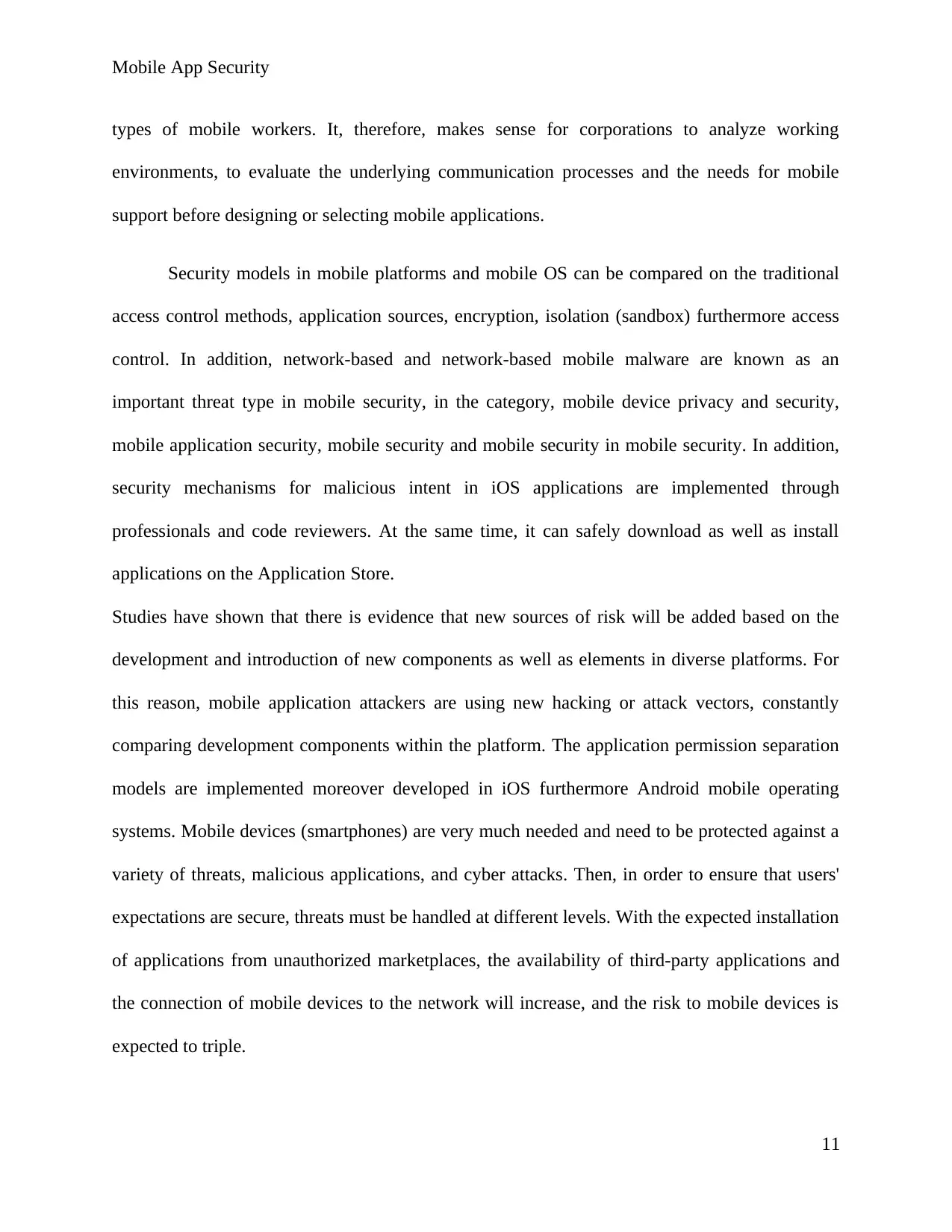
Mobile App Security
types of mobile workers. It, therefore, makes sense for corporations to analyze working
environments, to evaluate the underlying communication processes and the needs for mobile
support before designing or selecting mobile applications.
Security models in mobile platforms and mobile OS can be compared on the traditional
access control methods, application sources, encryption, isolation (sandbox) furthermore access
control. In addition, network-based and network-based mobile malware are known as an
important threat type in mobile security, in the category, mobile device privacy and security,
mobile application security, mobile security and mobile security in mobile security. In addition,
security mechanisms for malicious intent in iOS applications are implemented through
professionals and code reviewers. At the same time, it can safely download as well as install
applications on the Application Store.
Studies have shown that there is evidence that new sources of risk will be added based on the
development and introduction of new components as well as elements in diverse platforms. For
this reason, mobile application attackers are using new hacking or attack vectors, constantly
comparing development components within the platform. The application permission separation
models are implemented moreover developed in iOS furthermore Android mobile operating
systems. Mobile devices (smartphones) are very much needed and need to be protected against a
variety of threats, malicious applications, and cyber attacks. Then, in order to ensure that users'
expectations are secure, threats must be handled at different levels. With the expected installation
of applications from unauthorized marketplaces, the availability of third-party applications and
the connection of mobile devices to the network will increase, and the risk to mobile devices is
expected to triple.
11
types of mobile workers. It, therefore, makes sense for corporations to analyze working
environments, to evaluate the underlying communication processes and the needs for mobile
support before designing or selecting mobile applications.
Security models in mobile platforms and mobile OS can be compared on the traditional
access control methods, application sources, encryption, isolation (sandbox) furthermore access
control. In addition, network-based and network-based mobile malware are known as an
important threat type in mobile security, in the category, mobile device privacy and security,
mobile application security, mobile security and mobile security in mobile security. In addition,
security mechanisms for malicious intent in iOS applications are implemented through
professionals and code reviewers. At the same time, it can safely download as well as install
applications on the Application Store.
Studies have shown that there is evidence that new sources of risk will be added based on the
development and introduction of new components as well as elements in diverse platforms. For
this reason, mobile application attackers are using new hacking or attack vectors, constantly
comparing development components within the platform. The application permission separation
models are implemented moreover developed in iOS furthermore Android mobile operating
systems. Mobile devices (smartphones) are very much needed and need to be protected against a
variety of threats, malicious applications, and cyber attacks. Then, in order to ensure that users'
expectations are secure, threats must be handled at different levels. With the expected installation
of applications from unauthorized marketplaces, the availability of third-party applications and
the connection of mobile devices to the network will increase, and the risk to mobile devices is
expected to triple.
11
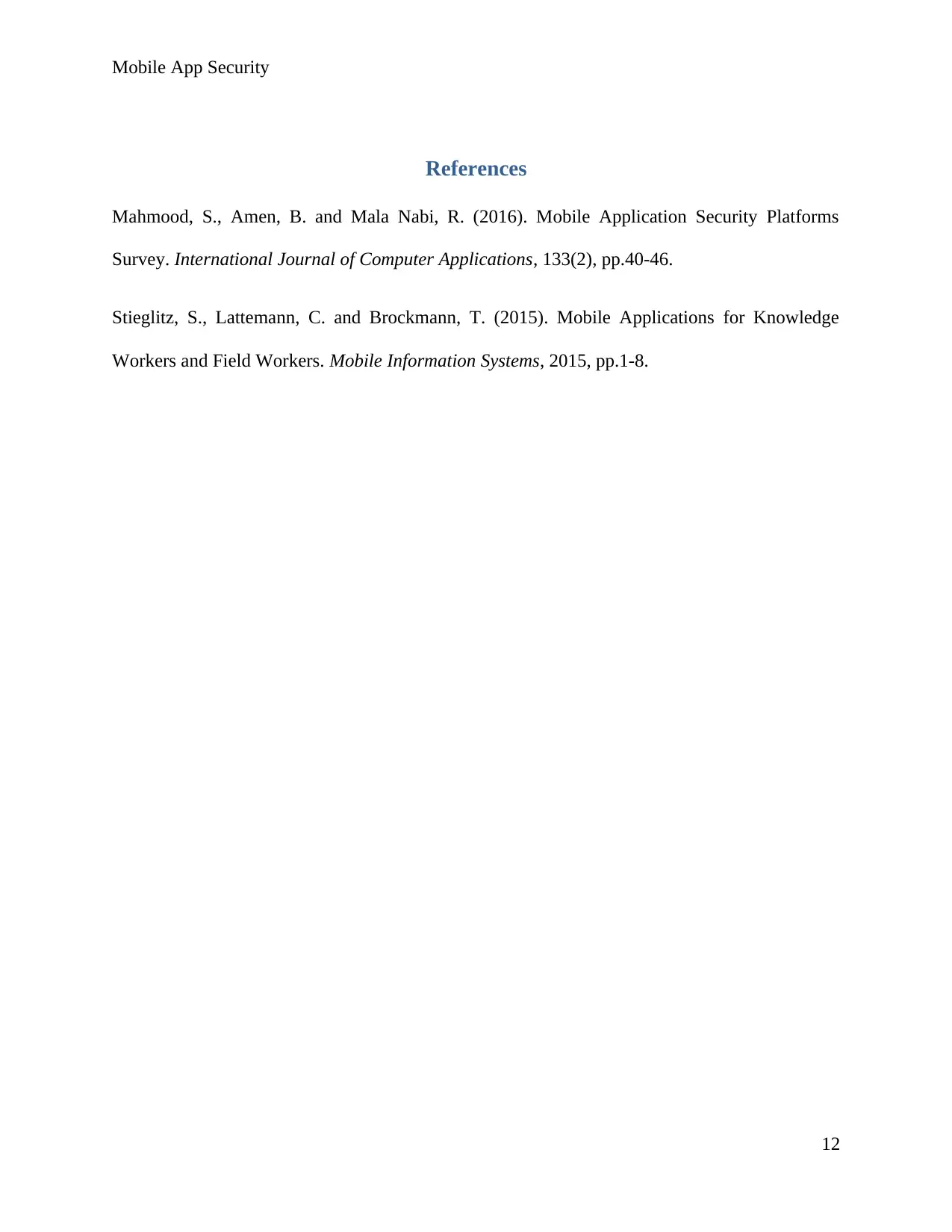
Mobile App Security
References
Mahmood, S., Amen, B. and Mala Nabi, R. (2016). Mobile Application Security Platforms
Survey. International Journal of Computer Applications, 133(2), pp.40-46.
Stieglitz, S., Lattemann, C. and Brockmann, T. (2015). Mobile Applications for Knowledge
Workers and Field Workers. Mobile Information Systems, 2015, pp.1-8.
12
References
Mahmood, S., Amen, B. and Mala Nabi, R. (2016). Mobile Application Security Platforms
Survey. International Journal of Computer Applications, 133(2), pp.40-46.
Stieglitz, S., Lattemann, C. and Brockmann, T. (2015). Mobile Applications for Knowledge
Workers and Field Workers. Mobile Information Systems, 2015, pp.1-8.
12
⊘ This is a preview!⊘
Do you want full access?
Subscribe today to unlock all pages.

Trusted by 1+ million students worldwide
1 out of 12
Related Documents
Your All-in-One AI-Powered Toolkit for Academic Success.
+13062052269
info@desklib.com
Available 24*7 on WhatsApp / Email
![[object Object]](/_next/static/media/star-bottom.7253800d.svg)
Unlock your academic potential
Copyright © 2020–2025 A2Z Services. All Rights Reserved. Developed and managed by ZUCOL.





